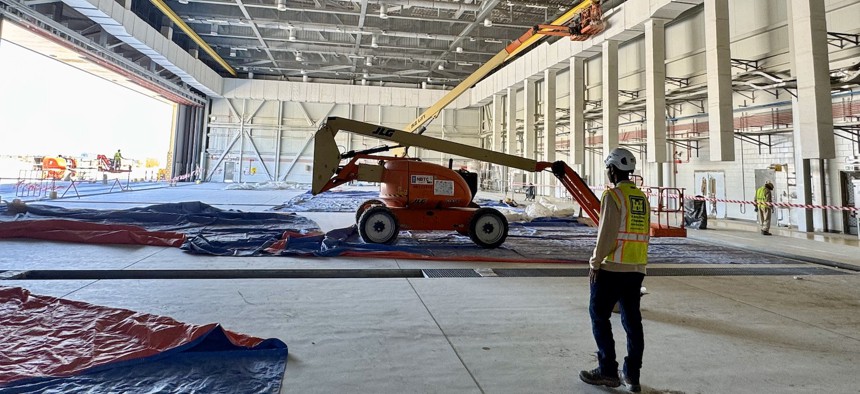
Issa Dioubate, U.S. Army Corps of Engineers Middle East District civil engineer, views progress on a maintenance facility, Mar. 25, 2025. The facility is part of a large-scale infrastructure project funded through Foreign Military Sales in the U.S. Central Command region. U.S. Army Corps of Engineers / Catherine Carroll
Defense acquisition, exports, and shipbuilding figure in trio of new executive orders
White House orders up plans and proposals for reducing costs and stimulating industrial base.
The White House on Wednesday released three defense-related executive orders: One to overhaul Pentagon acquisition, one to reform arms exports, and one to “restore American maritime dominance.”
The acquisition order aims to “reform our antiquated defense acquisition processes with an emphasis on speed, flexibility, and execution,” to “modernize the duties and composition of the defense acquisition workforce” and encourage them to take risks, the White House said Wednesday. All major defense acquisitions programs will be reviewed under the new order, and those “more than 15% behind schedule or 15% over cost will be scrutinized for cancellation.”
According to a White House fact sheet, nine Navy ship programs are between one and three years behind schedule, the new Air Force One is five years behind schedule, the first flight of the Air Force’s new ICBM is two years behind schedule and way over budget.
In the acquisition order, President Trump gives Defense Secretary Pete Hegseth 90 days to turn in a plan for a new acquisition system that, “to the maximum extent possible,” uses commercial solutions, prefers Other Transactions Authority to conventional acquisition approaches, uses “Rapid Capabilities Office policies”—(presumably ones developed by the Army, Air Force, or Space Force offices); or other streamlined methods under the Adaptative Acquisition Framework.
But even before that plan is turned in, the order says, the Pentagon must “prioritize” the use of these authorities for all contracting actions. Hegseth in March had sent a memo saying the Defense Department would default to rapid acquisition processes when buying software; the Defense Innovation Unit already primarily uses OTAs and Commercial Solutions Openings to work with commercial tech and has done about 550 OTAs using the CSO process since 2016.
Additionally, Hegseth must give Trump a plan to “reform, right-size, and train the acquisition workforce by focusing performance evaluations on how well the employee uses efficient procurement methods and takes calculated risks in order to innovate.”
Arms-export EO
A second order aims to bolster U.S. arms exports by reducing regulation and increasing government-industry cooperation. It also says it seeks to improve “accountability and transparency throughout the foreign defense sales system to ensure predictable and reliable delivery of American products to foreign partners and allies in support of U.S. foreign policy objectives.”
The order aims to streamline the rules involved in “developing and executing” foreign defense sales, require Hegseth and Secretary of State Marco Rubio to create a list of “priority partners” for conventional weapons sales, and “prioritize end-items for potential transfer to those partners.”
The order also sets a 90-day deadline for a plan to use “accountability metrics to improve transparency in defense sales, and moves the exportability requirement to be “earlier in the acquisition cycle.”
The leader of the Aerospace Industries Association, Eric Fanning, called the order “a welcome step.”
“With foreign military sales at historic levels, it’s clear the world wants that capability in even greater quantities…We look forward to updating a decades-old system to one that is transparent and efficient, responds to current global threats, and delivers jobs for the American people,” he said in a statement.
The total of U.S. weapons sold or transferred to other countries increased in fiscal 2024, to $117.9 billion, up from $80.9 billion the previous year, according to the State Department.
Maritime EO
Another order, “Restoring America’s Maritime Dominance,” aims to “revitalize and rebuild domestic maritime industries and workforce to promote national security and economic prosperity.”
It sets a Nov. 5 deadline for a plan to do this from a group that includes National Security Adviser Mike Waltz, the secretaries of State, Defense, Commerce, Labor, Transportation, Homeland Security, and others. Several of these people are tasked with assessing options—use of the Defense Production Act, or private investment—for boosting shipyards, parts makers, workforces, and more.
Among other things, the order sets a 45-day deadline for “recommendations to increase the number of participants and competitors within United States shipbuilding, and to reduce cost overruns and production delays for surface, subsurface, and unmanned programs”—with separate lists of recommendations for the Army, Navy, and Coast Guard. It also says the plan should include options for persuading shipbuilders in countries allied with the United States to invest in U.S. shipbuilding.
Rep. Joe Courtney, D-Conn., whose district includes submarine builder General Dynamics Electric Boat, applauded “the Administration’s interest” in improving naval readiness, investing in the maritime workforce, and accelerating shipbuilding. But Courtney added that Trump’s trade war is “undermining the progress this order seeks to achieve. The President's tariffs on steel and aluminum will increase the cost of contracts paid by the Government—and the taxpayer—and delay commercial contracts, inevitably risking shipyards business. That doesn’t add up for a President who seeks to ‘revitalize’ our domestic shipbuilding sector.”
